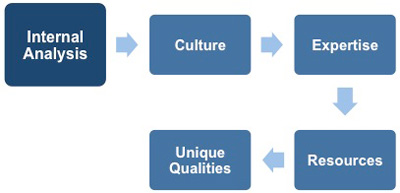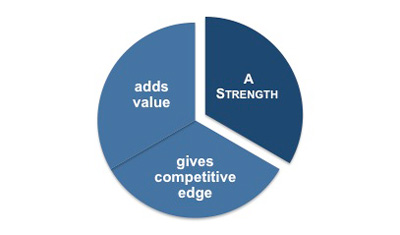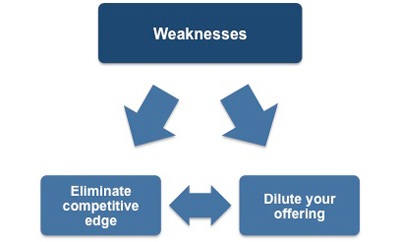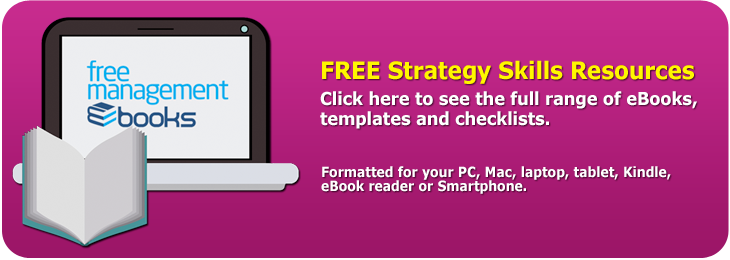Internal Factors - Strengths and Weaknesses

The internal analysis of your organization should include its culture, expertise, resources, and unique qualities within the market place. The extent to which your organization could adapt to changing circumstances is also a factor that needs to be considered.
 |
Within the broad area of 'culture' you should consider the different aspects of your organization's ethos, beliefs, public image, and structure.
Regarding expertise, how easy is this to retain or increase? How many of your people play a key role or have vital skills, and how does this compare to your competitors? To what extent does this 'expertise' help to maintain your organization's market share and brand positioning?
Resources include: financial position, buildings, plant, machinery, and other physical infrastructure.
Unique Qualities are those 'things' that are exclusive to your organization, such as special contracts, customers, patents, and trade secrets. Within this area you should also consider your research and development (R&D) capabilities.
You can then use the SWOT analysis as an interpretative filter to reduce the information to a manageable quantity of key issues that are relevant to your organization or to the business objective, depending on the level of the SWOT. At this stage you do not need to elaborate on each topic; you just need to decide if it is a strength or weakness.
Strengths
A 'strength' is something that has a positive implication. It adds value, or offers your organization a competitive advantage. Strengths include tangible assets such as available capital, equipment, credit, established and loyal customers, existing channels of distribution, copyrighted materials, patents, information and processing systems, and other valuable resources.
 |
You may want to look at and evaluate your strengths by function, for example marketing, finance, production, and support. Looking at things in this way can make it easier to identify the positive attributes within each function.
Certain teams may have specialist or unique knowledge, education, credentials, contacts, reputations, or backgrounds that provide a competitive advantage or add value to your product or service.
The sort of questions you can ask to ascertain your strengths are:
• What do we do well?
• What qualities or aspects persuaded our customers to choose our product or service?
• What resources do we have at our disposal?
• What do others see as our strengths?
• What areas are we seen as being expert in?
• What advantages do we have over our competition?
However you judge the responses to these questions it must be from the perspective of your operating environment and not from an internal aspect. For example, if 'guaranteed next day delivery' is the norm within your industry then this cannot really be considered a strength because your customers would expect it. On the other hand, if 'guaranteed next day delivery' is not normal in your industry then it could legitimately be classified as a strength.
Weaknesses
These are the characteristics of your product or service that are detrimental to growth. Weaknesses are those things that detract from the value of your offering or place you at a disadvantage when compared with your competitors.
 |
An obvious weakness would be an unsuitable location for your organization. For example,
You are located in the north of the country but 85% of your customers are in the south. This means that not only are your distribution costs significantly higher than some of your competitors but you are unable to offer guaranteed next day delivery in line with your competition.
Factors that are identified as weaknesses can often be remedied with suitable investment or restructuring. In the example above, it might be possible to relocate the business or set up a distribution center in the south of the country, but both of these things would require changes to the way the business currently operates.
The type of questions you would be asking and discussing to identify your weaknesses are:
• What can be improved or altered?
• What do we do badly?
• How do we compare with others?
• How does our performance compare with our competitors?
• What have our customers told us?
• How did we respond to this feedback?
• What should we avoid?
• How do third parties judge our performance or service?
• Have we self-imposed any constraints?
The more accurately you identify your weaknesses, the more valuable the SWOT analysis will be. However, because weaknesses are by definition internal there can be a lot of resistance to admitting to them. In fact, highlighting weaknesses can be synonymous with drawing attention to areas of the organization which have been badly managed or where poor decisions have been made. This can make it very difficult to talk about weaknesses objectively if you want to keep your job.
Do not lose sight of the fact that the existing senior management will be responsible for the current state of the organization. This is often an obstacle to a full and frank admission of organizational weaknesses.
Assuming that you do feel able to discuss your organization's weaknesses honestly, then it is important that you do so because the more realistic your assessment is at this stage the more value the SWOT analysis will have.
Many organizations use a simple matrix to compare the importance and significance of each of its strengths and weaknesses, referred to as a Performance-Importance Matrix. The level of importance is often simply shown as high, medium, or low, with the degree of significance rated as key, significant, minor, or neutral.
Those items you identify as being both important to your success and show a low performance for the organization are the factors your strategy should be addressing.
You may also be interested in: Definition of SWOT Analysis, Strengths, Weaknesses, Opportunities, and Threats, Internal Factors (Strengths and Weaknesses), External Factors (Opportunities and Threats), Matching and Converting, Advantages and Disadvantages and SWOT Analysis Example.



